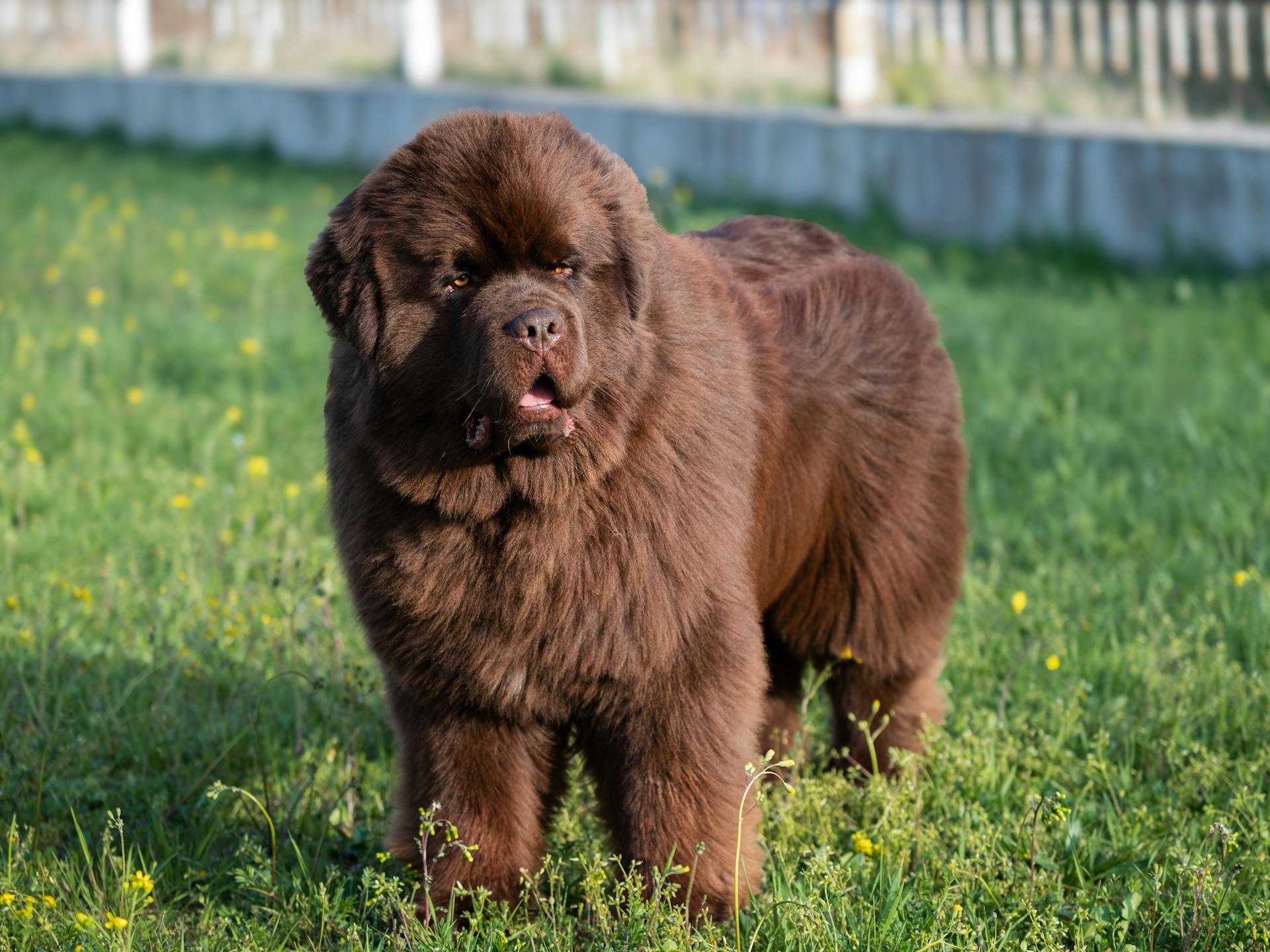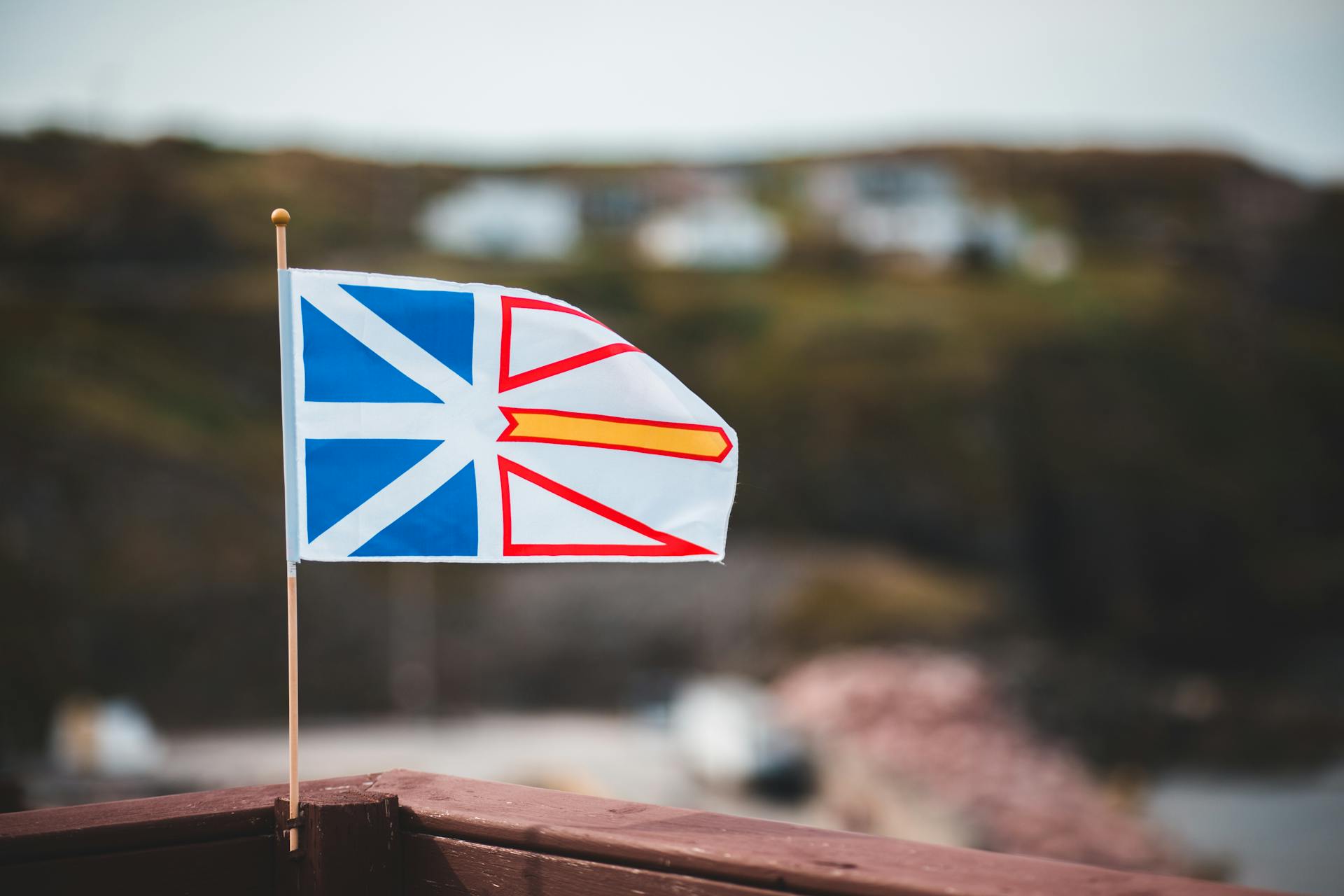
The majestic Newfoundland dog - a gentle giant with a heart of gold. They originated in the province of Newfoundland, Canada, where they were bred to help fishermen rescue those in distress.
Newfoundlands are a large breed, with males weighing up to 150 pounds and standing as tall as 28 inches at the shoulder. Their thick coat requires regular grooming to prevent matting and tangling.
Their webbed feet and water-resistant coat make them natural swimmers, and they've been known to save countless lives in the water.
Breed Characteristics
Newfoundlands are large dogs that require space, so a roomy environment is a must. They can thrive in cooler climates, but can also adapt to warmer climates with proper precautions.
Their thick coat needs regular grooming to stay in good condition. This can be a time-consuming task, but there's also the option of hiring a professional groomer.
Newfoundlands are known for their excessive drooling, so if you're not fond of dog slobber, this breed may not be for you.
Highlights
The Newfoundland is a large dog that requires space and would be happier in a roomier environment rather than a small apartment. They need regular exercise and mental stimulation, making training and dog sports an ideal way to channel their working abilities.
If you're not fond of dog slobber, the Newfoundland may not be the best choice for you - they're known for drooling excessively.
Maintaining their thick coat in good condition necessitates regular grooming, which can be time-consuming if you do it yourself.
Breed Characteristics
Newfoundlands are known for their webbed paws, which are perfect for swimming in the water. This feature, combined with their water-resistant coat, makes them well-suited for lifesaving exploits and water rescues.
These dogs come in a variety of colors, including black, brown, grey, and white-and-black. The Landseer pattern, named after artist Sir Edwin Henry Landseer, is a distinctive black and white marking that's still recognized as a separate breed by some organizations.
Suggestion: Landseer Dog
Newfoundlands are massive dogs, with males weighing between 65-80 kg (143-176 lb) and females weighing between 55-65 kg (121-143 lb). Some individuals have been known to weigh over 90 kg (200 lb), with the largest on record weighing 120 kg (260 lb).
The breed's large bones and powerful musculature give them the strength and endurance needed to tackle rough ocean waves and powerful tides. This makes them well-suited for swimming long distances and working in cold water.
Here's a quick rundown of the breed's standard colors, as recognized by different kennel clubs:
Their double coat is thick, oily, and waterproof, protecting them from the chill of icy waters. This coat, combined with their webbed paws and water-resistant features, makes them a formidable force in the water.
Care and Grooming
Newfoundlands are known for their thick, water-resistant double coat, which sheds moderately throughout the year, especially during the spring and fall shedding seasons.
To manage their shedding, brush your Newfie at least once a week with a slicker brush followed by a long-toothed comb to get rid of all the mats. You'll likely need to step it up to daily brushing sessions during shedding season.
They also drool, so be sure to keep a towel handy to clean their faces and your furniture. Regular grooming will help keep their coat healthy and prevent matting behind their ears.
Newfoundlands need regular physical activity, but it's essential to avoid having them run and play on hard surfaces like pavement until they're at least two years old. Normal play on grass is generally safe, as well as participating in puppy agility with one-inch jumps.
Swimming is an excellent exercise option for Newfoundland puppies as it helps build their muscles without risking joint injuries.
Size
Newfoundland dogs are quite the large breed, with males reaching a height of 28 inches at the shoulder.
Their size can make them a bit more challenging to care for, especially when it comes to exercise needs. Males can weigh up to 150 pounds, so they require regular physical activity to stay healthy.
Females, on the other hand, are slightly smaller, but still need plenty of exercise to maintain their overall health.
Dog Grooming Tips
Newfoundlands shed a lot, so be prepared for regular vacuuming, especially with a good vacuum that has attachments like telescoping wands and crevice tools.
Their thick, water-resistant double coat sheds moderately throughout the year, with heavy shedding in the spring and fall. This means you'll need a sturdy double-sided grooming brush to tackle thick mats and tangles.
You'll want to brush your Newfie at least once a week, and daily during shedding season. Don't forget to check their ears weekly for signs of infection.
Their floppy ears are prone to bacterial infections, so watch for redness, swelling, or debris and contact your vet if you notice anything unusual. Your vet may recommend you clean your dog's ears.
Worth a look: Vet Dogs Dog Treats
Newfies love being in the water, but you may not need to bathe them as often as other breeds. A bath every six to eight weeks should do the trick, unless they get into stinky water.
Daily brushing of their teeth is a must, starting when they're a puppy. This will help prevent plaque and tartar buildup, which can lead to health problems like heart disease.
Trim your Newfie's nails before they get long enough to click on the floor. Depending on how active your dog is, plan on cutting them every two to four weeks.
Care
Newfoundlands shed a lot and drool even more, so be prepared for regular grooming sessions. They need regular physical activity, but not long-distance running, which can injure their joints.
Swimming is an excellent exercise option for Newfoundlands, as it builds their muscles without putting excessive strain on their joints. They excel at swimming and have a natural love for the water.
Newfoundland puppies experience rapid growth between four and seven months of age, making them susceptible to bone disorders. It's essential to protect their growing joints by avoiding hard surfaces like pavement and high-impact activities.
Newfoundlands age more quickly than smaller dogs due to their large size, so regular veterinary check-ups are crucial. They need a balanced diet and plenty of exercise to maintain their health.
Newfoundlands are generally eager to please, making training relatively easy. Leash training is particularly important, especially considering they will reach over 100 pounds when fully grown.
Newfoundland puppies should start training as soon as they come home, and enrolling them in puppy kindergarten and obedience classes is highly recommended. This provides structured training and socialization opportunities.
Newfoundlands are friendly with just about everyone and everything, including cats and kids. However, they can accidentally knock over small children until they learn otherwise, so supervise playtimes carefully.
Regular exercise is essential to prevent obesity in Newfoundlands, and overeating can quickly lead to this issue. They excel at water sports and have a natural love for the water that makes them perfect for swimmers and frequent pool-goers.
Check this out: Dogs Getting Sick from Dog Food
Diet
Newfoundland dogs require high-quality food to maintain their size and health. They need 4 to 5 cups of dry food per day, divided into two meals.
Portion control is essential, so it's best to measure the food and feed them twice a day rather than leaving it out continuously. Each dog's food requirements vary based on their size, age, metabolism, and activity level.
Newfies can suffer from bloat, which can be life-threatening, so it's crucial to feed them smaller, more frequent meals throughout the day and use a slow feeder to prevent gobbling.
Exercise should be avoided for an hour before or after mealtimes to help prevent bloat. Your veterinarian can guide you on how much and how often to feed your dog based on their specific diet needs.
Newfoundland puppies require a diet that supports slow and steady growth, with 22 to 24 percent protein and 12 to 15 percent fat.
Take a look at this: What to Feed Dogs If Out of Dog Food
Health
As a responsible dog owner, it's essential to be aware of the potential health issues that can affect your purebred Newfoundland dog. Newfoundlands have a relatively modest lifespan, averaging 8 to 10 years, and are prone to certain health conditions.
Elbow and hip dysplasia are common issues in larger breeds, including Newfoundlands. These conditions occur when the joint doesn't form properly and can be painful for your pup.
Regular screening for hip dysplasia is recommended, and affected dogs should not be bred. Elbow dysplasia is also a hereditary condition common in large breeds, causing joint laxity and resulting in lameness.
Newfoundlands are also at risk for dilated cardiomyopathy (DCM), a heart condition that happens when the heart becomes enlarged and weak, preventing it from effectively pumping blood. This can eventually lead to congestive heart failure.
In addition to these conditions, Newfoundlands are also prone to gastric dilation-volvulus (GDV), a life-threatening emergency where the dog's stomach fills with gas and becomes twisted. This requires immediate medical intervention.
Here are some of the major health concerns for purebred Newfoundlands:
Newfoundlands are also prone to eye problems, such as entropion and ectropion, and may be sensitive to anesthesia. Regular veterinary check-ups and a balanced diet can help prevent or manage these conditions.
Temperament and Behavior
Newfoundlands are known for their patient and gentle personality, making them a great family dog.
They love being around their people and are naturally friendly with strangers, but they do need early socialization to understand how to play appropriately with other dogs.
Consistent training will help your Newfoundland puppy grow up to be a confident, well-mannered dog, and they thrive when in the company of their loved ones.
Newfoundlands are calm, patient, easygoing, gentle, and amiable - a friend to all - but they can act protectively if their family is threatened.
They're also very intelligent and have a strong desire to please their family, which makes them highly trainable.
Their patient and even-tempered personalities make them ideal family dogs, and they're often referred to as a "nanny dog" due to their gentle nature around children.
Temperament
Newfoundlands are known for their patient and gentle personality, making them a great fit for families with kids of all ages.
They love being around their people and are naturally friendly with strangers, which is why they're often referred to as "nanny dogs". Early socialization is crucial for Newfoundlands, and enrolling them in puppy kindergarten classes can help shape them into well-rounded and confident dogs.
Newfoundlands are calm, patient, easygoing, gentle, and amiable, a friend to all. They're not known for having aggressive tendencies, so pain is about the only reason a Newfoundland would growl or bite.
They're highly intelligent and have a strong desire to please their family, which makes training a breeze. Consistent training will help your Newfoundland puppy grow up to be a confident, well-mannered dog.
Newfoundlands are not suited for households that can't provide regular exercise and attention, as they thrive when in the company of their loved ones. Leaving them alone for extended periods or isolating them in the backyard or kennel can lead to behavioral issues.
They're naturally protective of their family and will act accordingly if they feel threatened. However, this doesn't mean they're aggressive; they're just fiercely loyal.
A unique perspective: Is a Rhodesian Ridgeback an Aggressive Dog
Training
Newfoundland dogs are intelligent and curious, which makes them a joy to train. They thrive on mental and physical stimulation, so it's essential to provide them with engaging activities and exercises.
Early socialization and training are crucial for Newfies, not because they can be aggressive, but because they often don't realize how big they are. This can lead to accidental knocking or tripping, so it's vital to teach them basic skills like sitting politely and leaving things alone.
Teaching your Newfie to come when called is also a must, and enrolling them in puppy play classes can help them learn how to play with other dogs appropriately. These classes also provide valuable socialization with other adults.
Newfoundland dogs love to work, so playing to their natural traits can be a great way to deepen your bond with your pup. Consider enrolling them in carting and drafting competitions, where they can pull carts for sport, or try other dog sports like agility, dock jumping, or flyball.
Positive reinforcement strategies are the best way to develop a relationship with your Newfoundland, so be sure to reward their good efforts with treats, praise, and fun play breaks with toys.
History and Origin
The Newfoundland breed originated in the Canadian province of Newfoundland in the 18th century. Fishermen relied on the dogs with their partially webbed feet and natural-born swimming abilities in water rescues and to haul fishing nets ashore.
Newfoundlands have been used as working dogs in various capacities, including pulling carts and serving as pack horses. They were eventually exported to England and are now found throughout the world.
The breed was recognized by the American Kennel Club in 1886 and has since become a popular companion animal.
Relationship to Other Breeds
The Newfoundland breed has a rich history of interbreeding with other breeds, resulting in some fascinating connections. The St. Bernard breed, for example, has Newfoundlands in their ancestry.
Many St. Bernards have inherited the Newfoundland's sturdy bone structure and broad snouts. This is no surprise, given that Newfoundlands were brought to the St. Bernard breed in the 18th century to help combat an epidemic of canine distemper.
For another approach, see: Saint Bernese Mountain Dog
Newfoundlands also share many characteristics with livestock guardian dog breeds, such as the Great Pyrenees. This is likely due to their shared history as working dogs.
The Newfoundland's strength and water rescue abilities made them a key part of the foundation stock for the Leonberger breed. The Canadian government even imported Newfoundlands for their water rescue expertise.
History
The Newfoundland breed has a rich history that spans centuries. It originated in the Canadian province of Newfoundland in the 18th century.
Fishermen relied on Newfoundlands with their partially webbed feet and natural-born swimming abilities in water rescues and to haul fishing nets ashore. Their immense lung capacity enables them to swim long distances.
Newfoundlands were used as working dogs for pulling carts or as a pack horse in the provinces of Newfoundland and Labrador. They were eventually exported to England.
In 1802, Lewis and Clark had a Newfoundland named Seaman as part of the expedition. The dog appears on 10 different monuments across the country.

Newfoundlands earned their reputation as a “nanny dog” for watching after Senator and Mrs. Robert F. Kennedy’s 11 children. The breed was recognized by the American Kennel Club in 1886.
The breed's existence faced a threat until the late 1800s when Professor Albert Heim of Switzerland identified and described the Newfoundland, contributing to its preservation.
Other Famous
Famous Newfoundlands have been a part of history and culture for centuries. The breed has been a symbol of Newfoundland and Labrador, and has even been the inspiration for various works of art.
Bashaw, a Newfoundland, was the Earl of Dudley's favorite dog and inspired a sculpture at the Victoria and Albert Museum in London. This is just one example of the breed's impact on art and culture.
Bilbo, a lifeguard Newfoundland, saved three lives on Sennen beach in Cornwall. He's a testament to the breed's natural instinct to help others.
Boatswain, Lord Byron's pet, was so beloved that the poet attempted to nurse him back to health when he contracted rabies. A monument was even built for him at Newstead Abbey.

Bouncer, a Newfoundland, was presented to the Duke and Duchess of Cornwall and York (later George V and Queen Mary) during their visit to the colony in 1901. He was a gift from the children of Newfoundland.
Frank, an unofficial mascot of the Orphan Brigade during the American Civil War, was a symbol of hope and comfort for the soldiers.
Gander, the World War II mascot of the Royal Rifles of Canada, was awarded the PDSA Dickin Medal retroactively in 2000 for his heroic actions during the Battle of Hong Kong.
Here are some of the most famous Newfoundlands:
- Bashaw
- Bilbo
- Boatswain
- Bouncer
- Frank
- Gander
- Gipsy
- Luath
- Neptune
- Rigel
- Sable Chief
- Seaman
Owning a Dog
Newfoundland dogs are a great choice for families with children, but it's essential to teach kids how to interact with them properly to ensure safety.
Supervision is necessary during interactions between dogs and young children to prevent any potentially harmful behavior.
Newfoundland dogs are generally easygoing and friendly towards other pets, including cats and small mammals, but proper socialization and training are crucial for harmonious relationships.
Regardless of a dog's friendliness, no dog should be left unsupervised with a child.
Newfoundland dogs can unintentionally knock over toddlers or small children due to their size and abundance of soft fur.
Specialized Topics
Newfoundland dogs are naturally talented swimmers, with a water-resistant coat and webbed feet that make them well-suited to life in the water.
Their dense, double coat is also highly effective at keeping them warm in cold water, but it can shed heavily, requiring regular grooming to prevent matting.
With their calm and gentle nature, Newfoundland dogs are often used as therapy dogs and search and rescue dogs.
Water Rescue
Newfoundlands have a long history of performing water rescues, and it's not just a coincidence. They were bred to be rugged working dogs, and their love for water is evident in their natural instinct to rescue people from drowning.
In fact, an unnamed Newfoundland is credited with saving Napoleon Bonaparte's life in 1815. Napoleon was swept overboard during his escape from exile on the island of Elba, but the brave dog kept him afloat until he could reach safety.
Newfoundlands have been known to save countless lives over the years. In 1828, a Newfoundland named Hairyman helped rescue over 160 Irish immigrants from the wreck of the brig Despatch.

Here are some notable examples of Newfoundlands' water rescue feats:
- An unnamed Newfoundland is credited with saving Napoleon Bonaparte in 1815.
- In 1828, a Newfoundland named Hairyman saved over 160 Irish immigrants from the wreck of the brig Despatch.
- In 1881, a Newfoundland named Nelson helped rescue Thomas Brown, a cab driver who was swept away by flood waters in Melbourne, Australia.
- In the early 20th century, a dog thought to be a Newfoundland saved 92 people from the SS Ethie, which was wrecked off the Northern Peninsula of Newfoundland during a blizzard.
- In 1995, a 10-month-old Newfoundland named Boo saved a hearing-impaired man from drowning in the Yuba River in Northern California.
These incredible stories demonstrate the Newfoundlands' natural ability to perform water rescues, even without formal training.
Three Little-Known Facts
Did you know that the shortest war in history was between Britain and Zanzibar on August 27, 1896, and lasted only 38 minutes? This tiny island nation surrendered after just 12 minutes of fighting, and the remaining 26 minutes were spent on ceasefire negotiations.
The shortest war in history was sparked by a dispute over who should be the ruler of Zanzibar. Britain had been trying to gain control of the island for years, and the war was a result of Zanzibar's refusal to accept British rule.
The Eiffel Tower was originally intended to be a temporary structure, built for the 1889 World's Fair in Paris. It was meant to be dismantled after the fair, but it became an instant icon of the city and was left standing.
A fresh viewpoint: Cane Corso Roman War Dog

In fact, the Eiffel Tower was so popular that it became a symbol of French culture and engineering prowess, and it's now one of the most recognizable landmarks in the world.
The shortest verse in the Bible is John 11:35, which reads, "Jesus wept." It's a powerful and poignant reminder of Jesus' humanity and compassion.
Frequently Asked Questions
How much is a purebred Newfoundland?
The cost of a purebred Newfoundland can range from $500 to $2500, depending on factors like lineage and breeder reputation. This price range may vary depending on individual circumstances, so it's worth researching further for a more accurate estimate.
What is the life expectancy of a Newfoundland dog?
Newfoundland dogs typically live between 8 to 10 years. However, their lifespan can be influenced by their size and potential health issues.
Featured Images: pexels.com


